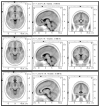α Power, α asymmetry and anterior cingulate cortex activity in depressed males and females
- PMID: 22939462
- PMCID: PMC3463760
- DOI: 10.1016/j.jpsychires.2012.08.003
α Power, α asymmetry and anterior cingulate cortex activity in depressed males and females
Abstract
Left fronto-cortical hypoactivity, thought to reflect reduced activity in approach-related systems, and right parietal hypoactivity, associated with emotional under-arousal, have been noted in major depressive disorder (MDD). Altered theta activity in the anterior cingulate cortex (ACC) has also been associated with the disorder. We assessed resting frontal and parietal alpha asymmetry and power in non-medicated MDD (N = 53; 29 females) and control (N = 43; 23 females) individuals. Theta activity was examined using standardized low-resolution electromagnetic tomography (sLORETA) in the ACC [BA24ab and BA32 comprising the rostral ACC and BA25/subgenual (sg) ACC]. The MDD group, and particularly depressed males, displayed increased overall frontal and parietal alpha power and left midfrontal hypoactivity (alpha(2)-indexed). They also exhibited increased sgACC theta(2) activity. MDD females had increased right parietal activity, suggesting increased emotive arousal. Thus, unmedicated depressed adults were characterized by lower activity in regions implicated in approach/positive affective tendencies as well as diffuse cortical hypoarousal, though sex specific modulations emerged. Altered theta in the sgACC may reflect emotion regulation abnormalities in MDD.
Copyright © 2012 Elsevier Ltd. All rights reserved.
Figures




Similar articles
-
Anterior cingulate volume predicts response to psychotherapy and functional connectivity with the inferior parietal cortex in major depressive disorder.Eur Neuropsychopharmacol. 2018 Jan;28(1):138-148. doi: 10.1016/j.euroneuro.2017.11.008. Epub 2017 Dec 1. Eur Neuropsychopharmacol. 2018. PMID: 29239789
-
Abnormal resting-state EEG phase dynamics distinguishes major depressive disorder and bipolar disorder.J Affect Disord. 2024 Aug 15;359:269-276. doi: 10.1016/j.jad.2024.05.095. Epub 2024 May 23. J Affect Disord. 2024. PMID: 38795776
-
Frontal and rostral anterior cingulate (rACC) theta EEG in depression: implications for treatment outcome?Eur Neuropsychopharmacol. 2015 Aug;25(8):1190-200. doi: 10.1016/j.euroneuro.2015.03.007. Epub 2015 Apr 20. Eur Neuropsychopharmacol. 2015. PMID: 25936227 Clinical Trial.
-
A review of fMRI studies during visual emotive processing in major depressive disorder.World J Biol Psychiatry. 2015 Oct;16(7):448-71. doi: 10.3109/15622975.2014.885659. Epub 2014 Mar 17. World J Biol Psychiatry. 2015. PMID: 24635551 Review.
-
Subgenual anterior cingulate cortex and hippocampal volumes in depressed youth: The role of comorbidity and age.J Affect Disord. 2016 Jan 15;190:726-732. doi: 10.1016/j.jad.2015.10.064. Epub 2015 Nov 12. J Affect Disord. 2016. PMID: 26600415 Review.
Cited by
-
Do we really measure what we think we are measuring?iScience. 2023 Jan 20;26(2):106017. doi: 10.1016/j.isci.2023.106017. eCollection 2023 Feb 17. iScience. 2023. PMID: 36844457 Free PMC article.
-
EEG Frequency Bands in Psychiatric Disorders: A Review of Resting State Studies.Front Hum Neurosci. 2019 Jan 9;12:521. doi: 10.3389/fnhum.2018.00521. eCollection 2018. Front Hum Neurosci. 2019. PMID: 30687041 Free PMC article. Review.
-
Effectiveness and Changes in Brain Functions by an Occupational Therapy Program Incorporating Mindfulness in Outpatients with Anxiety and Depression: A Randomized Controlled Trial.Neuropsychobiology. 2023;82(5):306-318. doi: 10.1159/000531487. Epub 2023 Aug 10. Neuropsychobiology. 2023. PMID: 37562374 Free PMC article. Clinical Trial.
-
No Alterations of Brain Structural Asymmetry in Major Depressive Disorder: An ENIGMA Consortium Analysis.Am J Psychiatry. 2019 Dec 1;176(12):1039-1049. doi: 10.1176/appi.ajp.2019.18101144. Epub 2019 Jul 29. Am J Psychiatry. 2019. PMID: 31352813 Free PMC article.
-
Transcranial alternating current stimulation for the treatment of major depressive disorder: from basic mechanisms toward clinical applications.Front Hum Neurosci. 2023 Sep 4;17:1197393. doi: 10.3389/fnhum.2023.1197393. eCollection 2023. Front Hum Neurosci. 2023. PMID: 37731669 Free PMC article. Review.
References
-
- Baehr E, Rosenfeld JP, Baehr R, et al. Comparison of two EEG asymmetry indices in depressed patients vs. normal controls. Int J Psychophysiol. 1998;31(1):89–92. - PubMed
-
- Bauer LO, Hesselbrock VM. Lateral asymmetries in the frontal brain: effects of depression and a family history of alcoholism in female adolescents. Alcohol Clin Exp Res. 2002;26(11):1662–8. - PubMed
-
- Beck AT, Steer RA, Brown GK. Manual for the Beck Depression Inventory-II. San Antonio (TX): Psychological Corporation; 1996.
-
- Bruder GE, Fong R, Tenke CE, et al. Regional brain asymmetries in major depression with or without an anxiety disorder: a quantitative electroencephalographic study. Biol Psychiatry. 1997;41(9):939–48. - PubMed
Publication types
MeSH terms
Grants and funding
LinkOut - more resources
Full Text Sources

